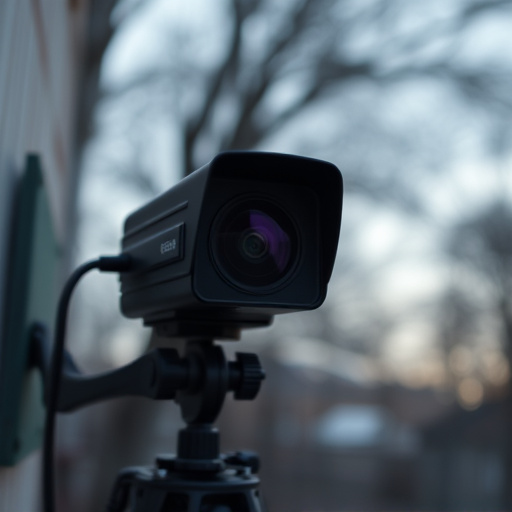Battery-powered wireless spy cameras offer flexible surveillance solutions with key features like battery life, resolution, and recording modes. To maximize their potential for location detection, users should prioritize durable batteries, low-power modes, and regular maintenance, such as battery replacement or solar options. Locating these cameras involves RF detection, signal strength triangulation, and strategic placement to minimize environmental obstacles. Effective deployment balances technological advantages with legal and ethical considerations, ensuring respect for privacy and maintaining public trust.
Wireless surveillance equipment, particularly battery-powered wireless spy cameras, has transformed home and business security. Understanding these compact yet powerful devices is crucial for effective location detection. This article guides you through mastering the art of locating hidden batteries, exploring advanced techniques and tools. Learn how to optimize signal strength for accurate identification while considering environmental variables. Additionally, we’ll delve into legal and ethical considerations surrounding the use of battery-powered wireless spy cameras.
- Understanding Battery-Powered Wireless Spy Cameras
- Locating Devices: Techniques and Tools
- Optimizing Signal for Accurate Detection
- Environmental Factors to Consider
- Legal and Ethical Guidelines for Surveillance
Understanding Battery-Powered Wireless Spy Cameras
Battery-powered wireless spy cameras have revolutionized surveillance, offering flexibility and convenience with their wireless capabilities and portable power sources. These devices are designed to operate autonomously, making them ideal for discreetly monitoring remote locations or areas where permanent wiring isn’t feasible. Understanding their unique features is essential when employing them for location detection. One key aspect to consider is the camera’s battery life, which can vary widely depending on factors like resolution, recording mode, and environmental conditions.
For optimal performance, choose cameras with durable batteries that support extended usage. Additionally, look for models featuring low-power modes or power-saving technologies to maximize battery lifespan. Regular maintenance, such as replacing batteries periodically or utilizing solar-powered options, ensures consistent surveillance. By understanding the intricacies of battery-powered wireless spy cameras, users can effectively leverage their capabilities in location detection, enhancing security and peace of mind.
Locating Devices: Techniques and Tools
Locating wireless surveillance equipment, particularly battery-powered spy cameras, requires a blend of technical know-how and strategic thinking. One effective technique is to use RF (Radio Frequency) detection tools that can pinpoint devices by analyzing their unique radio signals. These tools emit signals that interfere with the camera’s reception, causing it to transmit its location data unintentionally. This method is especially useful in environments where visual confirmation is difficult, like dense forests or crowded urban spaces.
Additionally, leveraging signal strength and triangulation techniques offers another powerful approach. By measuring the signal intensity between multiple devices and a known reference point, one can calculate the approximate location of the target camera. This requires specialized equipment capable of analyzing wireless network signals, but it’s a highly effective way to track down battery-powered spy cameras that might be hidden or disguised within a given area.
Optimizing Signal for Accurate Detection
To achieve accurate location detection using wireless surveillance equipment, optimizing signal strength is paramount. Battery-powered wireless spy cameras, for instance, should be strategically placed to ensure they have unobstructed lines of sight to the target areas. Avoid placing them behind walls, large objects, or in spaces that can cause signal interference. Regularly testing and calibrating these devices can also help improve detection accuracy.
Additionally, utilizing high-gain antennas designed specifically for wireless surveillance systems can significantly enhance signal quality. This is especially important in larger properties or urban environments where structural obstructions are more common. By focusing the signal and minimizing multi-path effects, these antennas enable better data transmission, resulting in more precise location tracking of connected devices.
Environmental Factors to Consider
When deploying battery-powered wireless spy cameras, environmental factors play a crucial role in ensuring optimal performance and accurate location detection. The first consideration is signal strength, which can be affected by physical obstructions like walls, floors, and ceilings. These barriers can interfere with Wi-Fi or Bluetooth signals, impacting the camera’s ability to transmit data and maintain a stable connection. Therefore, positioning cameras strategically to minimize such obstacles is essential for consistent performance.
Another critical factor is power management. Since battery-powered devices rely on finite energy sources, environmental conditions like temperature and humidity can affect battery life. Extreme temperatures, either too hot or too cold, can cause the batteries to drain faster. High humidity levels may also impact device functionality over time. Proper placement of cameras in controlled environments can help manage these factors and ensure the equipment remains operational for extended periods, enhancing location detection accuracy.
Legal and Ethical Guidelines for Surveillance
When deploying wireless surveillance equipment, such as battery-powered wireless spy cameras, it’s crucial to stay within the bounds of legal and ethical guidelines. In many jurisdictions, there are strict regulations regarding privacy and the use of surveillance technology. For instance, in the United States, the Digital Millennium Copyright Act (DMCA) prohibits the unauthorized installation of hidden cameras, while the Video Surveillance Device Act (VSDA) outlines specific requirements for visible and noticeable surveillance equipment.
In addition to legal constraints, ethical considerations play a vital role. Respecting individuals’ privacy is paramount, ensuring that any surveillance is conducted with transparency and justifiable reasons. Using battery-powered wireless spy cameras should be reserved for legitimate security concerns, not for invasive or intrusive monitoring. Always obtain consent when applicable and follow local laws to maintain public trust and avoid legal repercussions.
Wireless surveillance equipment, particularly battery-powered spy cameras, offer discreet monitoring solutions. Understanding their unique characteristics, such as those discussed in this article, is key to effective location detection. By mastering techniques like signal optimization and considering environmental factors, users can enhance the accuracy of their detection efforts. Always remember to adhere to legal and ethical guidelines when employing such technology, ensuring responsible and respectful surveillance practices.
